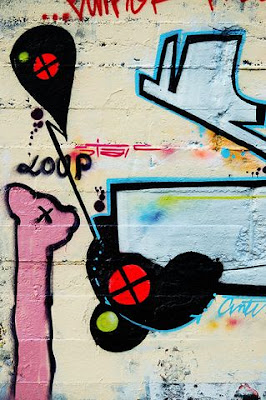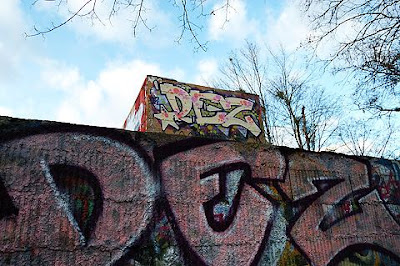 Graffiti writing became very competitive and artists trying to go "all cities", or had their names in the five boroughs of New York. Finally, the standards set in the early 70s began to become stagnant. This change attitude led many artists in the 1980s with a desire to expand and change.
Graffiti writing became very competitive and artists trying to go "all cities", or had their names in the five boroughs of New York. Finally, the standards set in the early 70s began to become stagnant. This change attitude led many artists in the 1980s with a desire to expand and change.Modern graffiti on trains
 The late 1970s and early 1980s brought a new wave of creativity to the scene. As the influence of graffiti was born in the Bronx, a graffiti movement began with the friendly encouragement Freddie. Fab 5 Freddy (Fred Brathwaite) is one of the graffiti popular personalities of the time, which began in Brooklyn "Wall-writing group." He noted how differences in spraying techniques and letters between Upper Manhattan and Brooklyn joined in the late 70s: "out of" Wild Style. "[26] Fab 5 Freddy is often credited d 'help spread the influence of graffiti and rap off the top foundations in the Bronx, and create links that most of the art center and white music scene. It was about this time that the world of art began to become established receptive to the graffiti culture for the first time since Hugo Martinez Razor Gallery in the 1970s.
The late 1970s and early 1980s brought a new wave of creativity to the scene. As the influence of graffiti was born in the Bronx, a graffiti movement began with the friendly encouragement Freddie. Fab 5 Freddy (Fred Brathwaite) is one of the graffiti popular personalities of the time, which began in Brooklyn "Wall-writing group." He noted how differences in spraying techniques and letters between Upper Manhattan and Brooklyn joined in the late 70s: "out of" Wild Style. "[26] Fab 5 Freddy is often credited d 'help spread the influence of graffiti and rap off the top foundations in the Bronx, and create links that most of the art center and white music scene. It was about this time that the world of art began to become established receptive to the graffiti culture for the first time since Hugo Martinez Razor Gallery in the 1970s. It also, however, the last wave of true bombing before the Transit Authority made graffiti eradication a priority. MTA (Metro Transit Authority) began to repair the garden fence, and removing graffiti consistent, struggling against a wave of graffiti artists. With the MTA combating cons artists remove their work often allows many artists to quit because of frustration, because they work constantly eliminated.
It also, however, the last wave of true bombing before the Transit Authority made graffiti eradication a priority. MTA (Metro Transit Authority) began to repair the garden fence, and removing graffiti consistent, struggling against a wave of graffiti artists. With the MTA combating cons artists remove their work often allows many artists to quit because of frustration, because they work constantly eliminated.